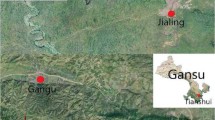Summary
The Rheology of Spacially Continuous Mass Creep in Rock
Reports on spatially continuous mass creep in rock of the Eastern Alps have been selected from the literature. The information contained therein has been collated with four rheological models (generalized Newtonian fluid, Bingham body, logarithmic creep, Kelvin body) in order to test their applicability. The following conditions must be fulfilled by these rheological models:
-
1.
The creep velocity and the state of stress prevailing at the beginning of the creeping motion (end of the last ice age) are fairly well known from the extrapolation of present day observations.
-
2.
The state of stress at the present time and the total displacement since the beginning of the motion are known.
-
3.
The deformation must be spatially continuous and not a block motion.
-
4.
The deformation cannot be fully recoverable.
Only the rheological model of logarithmic creep is appropriate to meet all these conditions.
Zusammenfassung
Die Rheologie des räumlich-kontinuierlichen Massenkriechens im Fels
Aus der Literatur wurden Beschreibungen von räumlich kontinuierlichem Massenkriechen im Fels innerhalb der Ostalpen ausgewählt. Die Feldbeobachtungen wurden mit vier rheologischen Modellen (verallgemeinerte Newtonsche Flüssigkeit, Bingham-Körper, logarithmisches Kriechen, Kelvin-Körper) verglichen. Um auf das räumlich kontinuierliche Massenkriechen anwendbar zu sein, müssen die rheologischen Modelle folgende Bedingungen erfüllen:
-
1.
Die Kriechgeschwindigkeit und der Spannungszustand zu Beginn der Kriechbewegung (Ende der letzten Eiszeit) sind aus der Extrapolation von gegenwärtigen Beobachtungen annähernd bekannt.
-
2.
Der jetzige Spannungszustand und die gesamte Verschiebung seit Beginn der Kriechbewegung sind bekannt.
-
3.
Die Deformation muß räumlich kontinuierlich sein und darf keine Blockbewegung ergeben.
-
4.
Die Deformation kann sich nicht zur Gänze erholen.
Nur das rheologische Modell des logarithmischen Kriechens entspricht allen Beobachtungsbefunden.
Résumé
La rhéologie du fluage continu en espace des roches
Des rapports sur le fluage continu des roches dans les Alpes orientales ont été choisis dans la littérature. L'information ainsi obtenu a été comparée avec quatre modèles rhéologiques (fluide de Newton généralisé, matériau de Bingham, fluage logarithmique, matériau de Kelvin) afin de vérifier leur applicabilité. Les conditions suivantes doivent être satisfaites par ces modèles rhéologiques:
-
1.
La vitesse du fluage et les contraintes prévalentes au commencement du fluage (à la fin de la glaciation la plus récente) sont assez bien connues par une extrapolation des observations récentes.
-
2.
Les contraintes dans le présent et le déplacement total depuis la dernière glaciation sont connus.
-
3.
La déformation doit être continue dans l'espace et ne doit pas se faire “en bloc”.
-
4.
La déformation ne peut pas être complètement reversible.
Seul le modèle rhéologique du fluage logarithmique convient à toutes ces conditions.
Similar content being viewed by others
References
Ampferer, O.: Über einige Formen der Bergzerreißung. Siztungsber. Akad. d. Wiss. Wien, math.-nat. Kl., Abt. I,148 1–14 (1939).
Ampferer, O.: Zum weiteren Ausbau der Lehre von den Bergzerreißungen. Sitzungsber. Akad. d. Wiss. Wien, math.-nat. Kl., Abt. I,149 51–70 (1940).
Clar, E., and P. Weiss: Erfahrungen im Talzuschub des Magnesit-Bergbaues Millstätter Alpe, Berg- und Hüttenmänn. Mon.-H. Leoben110 (12), 447–460 (1965).
Horninger, G.: Einiges über Talzuschübe und deren Vorzeichen. Geologie und Bauwesen24 37–45 (1958).
Lauffer, H., E. Neuhauser und W. Schober: Der Auftrieb als Ursache von Hangbewegungen bei der Füllung des Gepatschspeichers. Österreichische Ingenieur-Zeitschrift14 (4), 101–113 (1971).
Stiny, J.: Unsere Täler wachsen zu. Geologie und Bauwesen13 71–79 (1941).
Terzaghi, K.: Discussion on: Earth pressure, retaining walls, tunnels and shafts in soil. Proc. 3rd Int. Conf. on Soil Mech. a. Round. Eng. Zürich3 205–206 (1953).
Timoshenko, S. P., and J. N. Goodier: Theory of Elasticity, 3rd ed., 551. New York: McGraw-Hill, 1970.
Zischinsky, U.: Bewegungsbilder instabiler Talflanken. Mitt. Gesellsch. Geol. Bergbaustud. Wien17 127–167 (1966).
Zischinsky, U.: Über Sackungen. Rock Mechanics1 30–52 (1968).
Author information
Authors and Affiliations
Additional information
With 3 Figures
Rights and permissions
About this article
Cite this article
Brückl, E., Scheidegger, A.E. The rheology of spacially continuous mass creep in rock. Rock Mechanics 4, 237–250 (1972). https://doi.org/10.1007/BF01239033
Received:
Issue Date:
DOI: https://doi.org/10.1007/BF01239033




